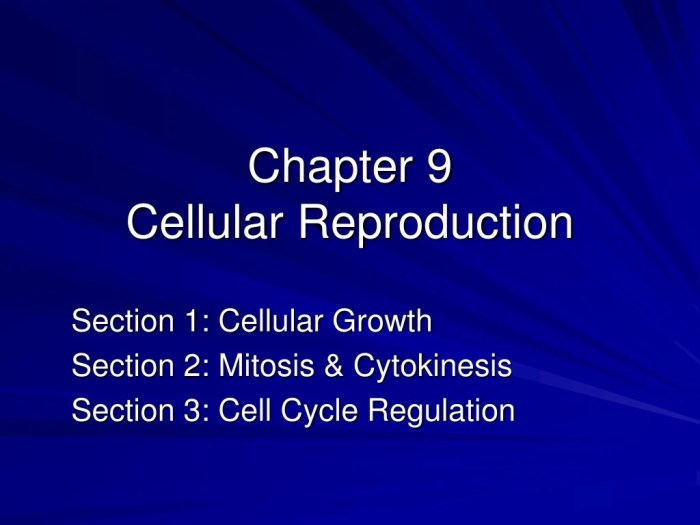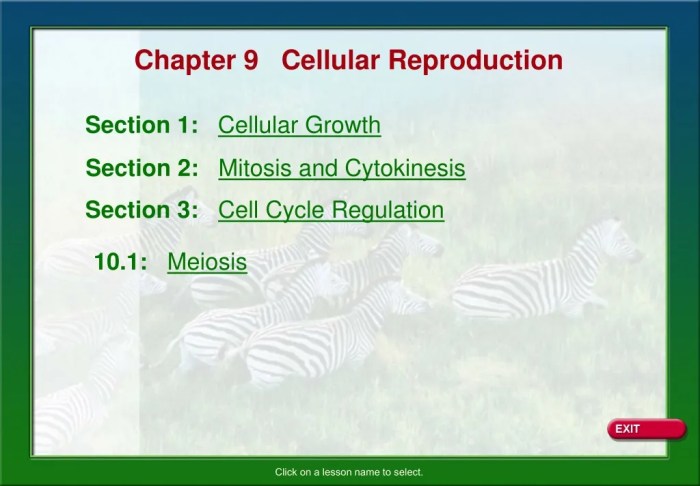Chapter 9 section 1 cellular growth – Chapter 9, Section 1: Cellular Growth sets the stage for an engrossing exploration into the fundamental processes that govern the growth and division of cells. This section delves into the intricacies of mitosis and meiosis, unraveling the mechanisms that ensure the faithful transmission of genetic material during cell division.
Cellular growth is a cornerstone of tissue and organ development, shaping the complexity and functionality of living organisms. This section sheds light on the intricate interplay between DNA replication and cell growth, providing a deeper understanding of the cellular processes that underpin life.
1. Cellular Growth and Division

Cellular growth is the process by which cells increase in size and number. This process is essential for the development and maintenance of all living organisms. Cell growth occurs through a series of stages, including cell division, DNA replication, and protein synthesis.
Cell division is the process by which a cell divides into two or more daughter cells. There are two main types of cell division: mitosis and meiosis. Mitosis is the process by which a cell divides into two identical daughter cells.
Meiosis is the process by which a cell divides into four daughter cells, each with half the number of chromosomes as the parent cell.
DNA replication is the process by which a cell makes a copy of its DNA. This process is essential for cell division, as it ensures that each daughter cell has a complete copy of the genetic material.
Protein synthesis is the process by which a cell makes proteins. Proteins are essential for a variety of cellular functions, including growth, repair, and metabolism.
Cell growth contributes to tissue and organ development. For example, the growth of new cells in the skin helps to repair wounds. The growth of new cells in the bones helps to increase bone strength. The growth of new cells in the muscles helps to increase muscle mass.
2. Regulation of Cell Growth
The growth of cells is regulated by a variety of factors, including growth factors and cell cycle checkpoints.
Growth factors are proteins that stimulate cell growth. They are produced by a variety of cells in the body, including fibroblasts, platelets, and macrophages. Growth factors bind to receptors on the surface of target cells, which then trigger a series of intracellular events that lead to cell growth.
Cell cycle checkpoints are points in the cell cycle at which the cell checks for errors. If an error is detected, the cell cycle will be halted until the error is corrected. Cell cycle checkpoints help to ensure that cells only divide when they are healthy and have a complete copy of the genetic material.
Disruptions in cell growth regulation can lead to diseases such as cancer. Cancer is a disease in which cells grow and divide uncontrollably. This can lead to the formation of tumors, which can damage surrounding tissues and organs.
Apoptosis is a process of programmed cell death. It is essential for the development and maintenance of all living organisms. Apoptosis helps to remove damaged or unwanted cells from the body. Disruptions in apoptosis can lead to diseases such as cancer.
3. Cell Growth and Differentiation

Cell differentiation is the process by which cells become specialized in function. This process occurs during embryonic development and continues throughout adulthood.
Gene expression is the process by which the genetic information in DNA is used to make proteins. The pattern of gene expression in a cell determines its function. For example, a cell that expresses the gene for insulin will produce insulin, a hormone that regulates blood sugar levels.
Cell differentiation contributes to the development of complex organisms. For example, the differentiation of cells in the skin leads to the formation of different layers of skin, each with its own unique function. The differentiation of cells in the brain leads to the formation of different regions of the brain, each with its own unique function.
4. Cell Growth and Aging: Chapter 9 Section 1 Cellular Growth

The growth of cells changes as organisms age. In general, the rate of cell growth decreases with age. This is due to a number of factors, including a decrease in the production of growth factors and an increase in the number of cell cycle checkpoints.
Telomeres are regions of DNA that are located at the ends of chromosomes. Telomeres shorten each time a cell divides. When telomeres become too short, the cell can no longer divide and will eventually die.
The shortening of telomeres is one of the main causes of aging. As we age, our cells divide less frequently and eventually die. This can lead to a decline in tissue and organ function, which can contribute to the development of age-related diseases.
Q&A
What is the role of DNA replication in cell growth?
DNA replication ensures the accurate duplication of genetic material, creating two identical copies of DNA. This process is essential for cell growth and division, ensuring that each daughter cell receives a complete set of genetic information.
How does cell growth contribute to tissue and organ development?
Cell growth is a fundamental process in tissue and organ development. As cells grow and divide, they differentiate into specialized cell types, forming the diverse tissues and organs that make up complex organisms.
What factors regulate cell growth?
Cell growth is regulated by a complex interplay of factors, including growth factors, cell cycle checkpoints, and the availability of nutrients. These factors ensure that cell growth is coordinated and controlled, preventing uncontrolled proliferation.